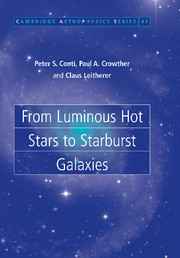Book contents
- Frontmatter
- Contents
- Preface
- Acknowledgements
- 1 Introduction
- 2 Observed properties
- 3 Stellar atmospheres
- 4 Stellar winds
- 5 Evolution of single stars
- 6 Binaries
- 7 Birth of massive stars and star clusters
- 8 The interstellar environment
- 9 From giant HII regions to HII galaxies
- 10 Starburst phenomena
- 11 Cosmological implications
- References
- Acronyms
- Symbols
- Object index
- Subject index
8 - The interstellar environment
Published online by Cambridge University Press: 28 October 2009
- Frontmatter
- Contents
- Preface
- Acknowledgements
- 1 Introduction
- 2 Observed properties
- 3 Stellar atmospheres
- 4 Stellar winds
- 5 Evolution of single stars
- 6 Binaries
- 7 Birth of massive stars and star clusters
- 8 The interstellar environment
- 9 From giant HII regions to HII galaxies
- 10 Starburst phenomena
- 11 Cosmological implications
- References
- Acronyms
- Symbols
- Object index
- Subject index
Summary
Several textbooks discuss the interstellar medium in depth, notably The Physics of the Interstellar Medium (Dyson & Williams 1997) and The Physics and Chemistry of the Interstellar Medium (Tielens 2005). This chapter focuses on aspects relevant to massive stars, namely the properties of interstellar dust, ionized nebulae surrounding individual O stars (giant HII regions are discussed later on), wind blown bubbles and ejecta nebulae around LBVs and W-R stars.
Diffuse gas in the ISM may be in a neutral or ionized form, of which 90% is in the form of hydrogen, either in an atomic, molecular, or ionized state. Cold (∼100 K), atomic hydrogen can be traced via the 21 cm (1420 MHz) hyperfine line, first predicted by van de Hulst (Bakker & van de Hulst 1945) and observed by Ewen & Purcell (1951). This provided the key means of mapping out the structure of the Milky Way and external galaxies. The Lyman series of neutral hydrogen can also be observed in the UV against a suitably hot background source.
Most of the cold (∼10 K) molecular ISM is in the form of H2. This molecule, however, does not emit at radio wavelengths. Since H2 is well correlated with carbon monoxide (CO), the CO emission at 1.3 and 2.6 mm is used as a proxy for H2.
- Type
- Chapter
- Information
- From Luminous Hot Stars to Starburst Galaxies , pp. 180 - 196Publisher: Cambridge University PressPrint publication year: 2008

